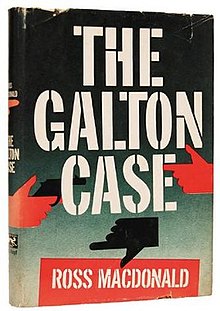Lew Archer
| Lew Archer | |
|---|---|
| First appearance | The Moving Target |
| Last appearance | The Blue Hammer |
| Created by | Ross Macdonald |
| Information | |
| Gender | Male |
| Occupation | Private detective |
| Nationality | American |
|
First print cover of The Galton Case
|
|
| Author | Ross Macdonald |
|---|---|
| Country | US |
| Language | English |
| Series | Lew Archer |
|
Release number
|
8 |
| Genre | noir |
| Set in | 1950s-60s |
| Published | 1959 |
| Publisher | Alfred A. Knopf, Inc. |
| Pages | 186 |
| Preceded by | The Doomsters |
| Followed by | The Wycherly Woman |
Lew Archer is a fictional character created by Ross Macdonald. Archer is a private detective working in Southern California. Between the late 1940s and the early 1970s, the character appeared in 18 novels and a handful of shorter works as well as several film and television adaptations. Macdonald's Archer novels have been praised for building on the foundations of hardboiled fiction by introducing more literary themes and psychological depth to the genre. Critic John Leonard declared that Macdonald had surpassed the limits of crime fiction to become "a major American novelist" while Pulitzer Prize winning author Eudora Welty was a fan of the series and carried on a lengthy correspondence with Macdonald. The editors of Thrilling Detective wrote: "The greatest P.I. series ever written? Probably."
Stephen White is the current rights holder of Lew Archer and the book series.
Initially, Lew Archer was similar to (if not completely a derivative of) Philip Marlowe, the pioneering sleuth created by Raymond Chandler in the 1930s. However, Macdonald eventually broke from that mold, though some similarities remain. Archer's principal difference is that he is much more openly sensitive and empathetic than the tough Marlowe. He also serves a different function from Marlowe. Chandler's books were primarily studies of Marlowe's character and code of honor, while Macdonald used Archer as a lens to explore the relationships of the other characters in the novels. Macdonald wrote, "Certainly my narrator Archer is not the main object of my interest, nor the character with whose fate I am most concerned," and moreover that Archer "is not their [the novels'] emotional center."
Another subtle difference was that Marlowe prowled the city of Los Angeles during the 1940s, while Lew Archer primarily worked the suburbs in the 1950s, moving outward with the populace. Like Marlowe, Archer observes growing dichotomies in American society with visual "snapshots". In The Zebra-Striped Hearse, Archer hunts a missing girl who may be dead, possibly murdered. His path repeatedly crosses a group of young surfers who own a hearse painted in gay zebra stripes. To the youngsters, death is remote and funny. To the world-weary detective, it's close and grim.
...
Wikipedia

